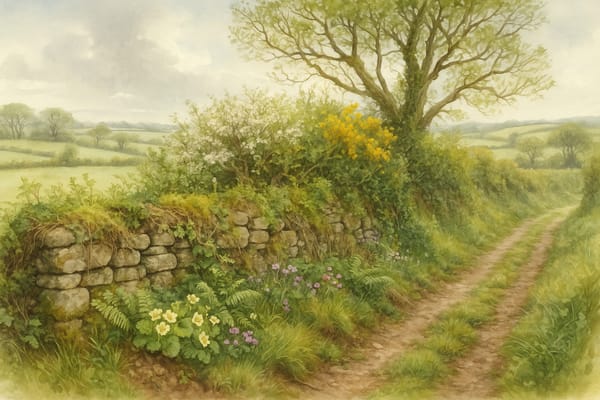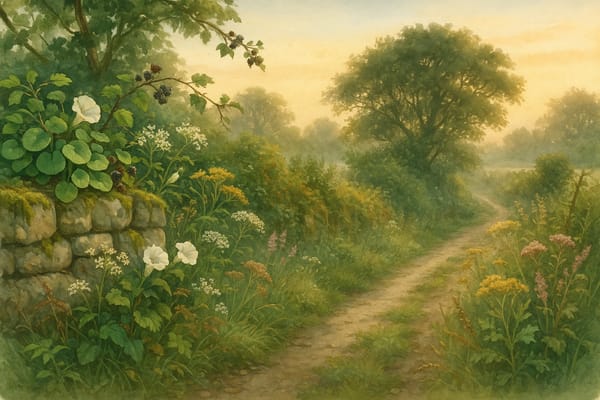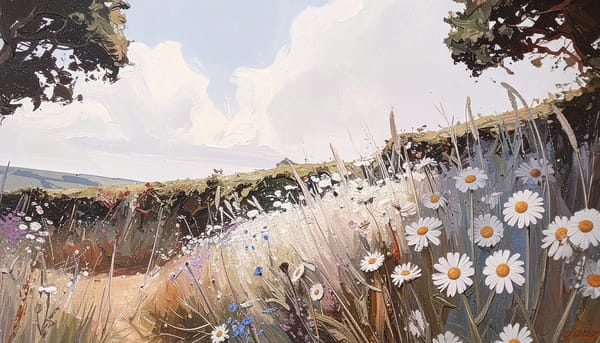There’s a certain kind of garden you stumble upon in Cornwall that feels as though it has grown out of the land itself. A patchwork of petals, stone, and sea air, it whispers of old stories and forgotten summers. Here, foxgloves lean into the breeze, Erigeron cascades from old walls, and a fig tree curls quietly around the doorway. This is Cornish cottagecore — a style not built but allowed, coaxed gently into being by salt, wind, time, and love.
More than a trend, Cornish cottagecore is a feeling. It speaks of abundance without artifice, of beauty shaped by the hand of nature and held together by generations of quiet tending. It is the romance of the rambling, the charm of the slightly unkempt, and the peace found in a place that hums with bees and memory.
What Is Cornish Cottagecore?
Rooted in classic English cottage gardening, Cornish cottagecore carries an added wildness, shaped by the region’s distinctive climate and coast. It is part garden, part haven, part expression of place — where sea-facing winds, mild wet winters, and long-growing seasons allow lush planting and layered texture to thrive.
At its heart, this style celebrates informality. Plants spill over gravel paths and tumble from terracotta pots. Stone walls cradle self-seeding blooms. Weathered benches invite pause. It’s not about perfection, but personality — a lived-in, evolving garden that grows richer each season.
The Signature Look
In a Cornish cottagecore garden, borders are brimming. There is no empty space, no clipped rigidity. Instead, there is movement, density, and joyful disorder.
The planting is layered and exuberant. Tall spires of delphiniums and foxgloves rise behind frothy nigella, nasturtiums, and hardy geraniums. Cosmos dance through the mix, joined by cornflowers and calendula. Hydrangeas and rambling roses provide anchor points, their foliage softening the stone.
Paths meander. Gravel, slate, or stepping stones wind through the garden, their edges softened by Erigeron (“Cousin Jack”), sea pinks, or thyme. The boundaries — often dry stone walls or traditional Cornish hedges — are alive with mosses, ferns, and slow worms tucked into the cool crevices.
The garden feeds both people and pollinators. Lavender and rosemary fringe the beds. Strawberries, herbs, and salad greens hide among the florals. Bug hotels nestle behind camellias. Birdbaths catch the sky. You’ll find the occasional duck waddling past, or a robin perched boldly on the handle of a garden fork.
A Garden That Breathes With the Land
Cornwall’s gardens are born from their environment — they must be. The weather is generous with rain and often quick to change. Mild temperatures allow for a wider plant palette, but coastal winds demand resilience. Gardeners in Cornwall know the value of shelter — not just for plants, but for themselves too.
That’s why Cornish cottagecore gardens often include:
- Winding paths with protected corners and seating nooks
- Stone walls and banks that deflect wind and create microclimates
- Wildlife corridors and undisturbed areas where biodiversity thrives
- Coastal-tolerant planting like agapanthus, echium, crinum lilies, and Cordyline australis (“Cornish palm”) that nod to both heritage and hardiness
A Living Tapestry
One of the most endearing qualities of Cornish cottagecore is its permission to be messy. To let plants self-seed. To leave a patch of grass long. To allow last year’s nigella to find its own place this season.
This is not laziness but love — a trust in the land’s rhythms. A garden becomes not just a place of cultivation, but of co-creation. The gardener becomes a steward, not a stylist.
Even in winter, the structure remains. Evergreen shrubs, clipped yews, or the bold lines of holly and bay give shape to the softness. Snowdrops and camellias bloom when little else does. Lichen clings to the stone. The garden is never truly bare.
Creating Your Own Cornish Cottagecore Garden
You don’t need to live on a cliff’s edge or beside a winding Cornish lane to adopt this style. What matters is the approach — intuitive, generous, deeply connected to nature.
Here’s how to begin:
- Choose plants that suit your climate, but let them mix freely. Include classics like foxgloves, cosmos, marigolds, delphiniums, and roses, layered with local wildflowers or edible herbs.
- Use local or weathered materials. Stone, slate, wood, and terracotta help create an authentic, grounded feel.
- Let the wildlife in. Add a water bowl, leave a corner untidy, plant pollinator favourites like lavender, borage, or honeysuckle.
- Think in layers. Underplant shrubs with bulbs, trail daisies through gravel, let climbers rise over arches and fences.
- Include a personal touch. Whether it’s an old teacup tucked into the border, a fig tree by the door, or a salvaged bench under the apple tree — your garden should reflect you.
And above all, don’t strive for perfection. Let the garden ramble. Let the foxglove self-seed. Let the wind shape it. You’re not curating, you’re collaborating.
Cornish cottagecore is not about recreating a bygone era — it’s about embracing a way of living that honours the land, welcomes the wild, and finds beauty in the everyday. It is a garden style, yes, but also a mindset. One that invites slowness, nurtures connection, and celebrates imperfection.











